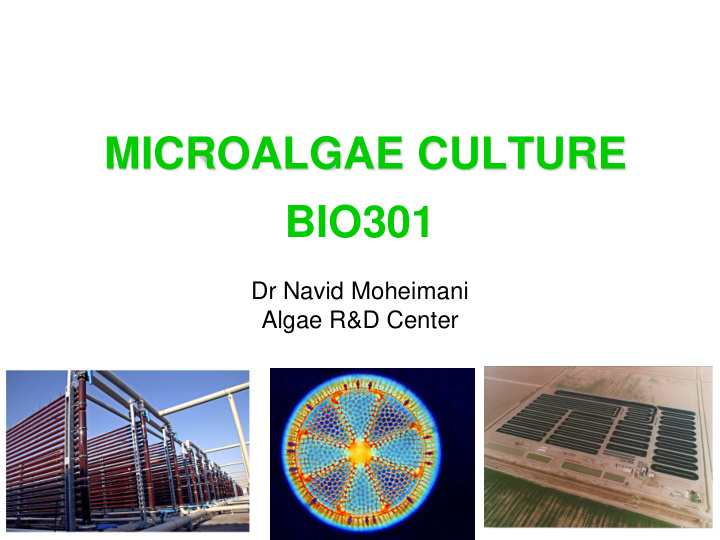



MICROALGAE CULTURE BIO301 Dr Navid Moheimani Algae R&D Center
Dr Navid Moheimani n.moheimani@murdoch.edu.au 9360 2682
What are algae? simple, non-flowering, and typically aquatic plants of a large assemblage that includes the seaweeds and many single- celled forms . Algae contain chlorophyll but lack true stems, roots , leaves, and vascular tissue.
Algae VS Bacteria Photosynthesis • What is photosynthesis: • Date: 1898 synthesis of chemical compounds with the aid of radiant energy and especially light; especially : formation of carbohydrates from carbon dioxide and a source of hydrogen (as water) in the chlorophyll-containing tissues of plants exposed to light (http://www.merriam-webster.com/dictionary/photosynthesis) • It is an improbable process (uphill reaction)
Sugar + O 2 energy Photosynthesis Metabolism Solar energy CO 2 + H 2 O
Photosynthesis: • What is photosynthesis: • Date: 1898 synthesis of chemical compounds with the aid of radiant energy and especially light; especially : formation of carbohydrates from carbon dioxide and a source of hydrogen (as water) in the chlorophyll-containing tissues of plants exposed to light (http://www.merriam-webster.com/dictionary/photosynthesis) • It is an improbable process (uphill reaction) • Oxygenic photosynthesis is one of the key fundamental biological process which support life on the earth. • Chloroplast are responsible for trapping light energy and convert it to Chemical energy
Habitats • Water (freshwater to hypersaline brines) • Soil • Trees etc. • Symbionts of lichens, ferns, cycads, sponges, molluscs, corals, flatworms etc etc.
• Salinity : freshwater to saturated brines
Dinophyta Dinophyta Dinophyta Euglenophyta S! S! S! Heterotrophic dinoflagellate Heterokontophyta Haptophta S! Chlorophyta Cryptophyta Chloroplast Lost S! S! Rhodophyta S! Dinophyta Loss of phycobilisomes Formation of chlorophyll b Small subunit RuBisCo gene transferred to nucleus S! Primaeval Brown Flagella lost Hetrotrophic Flagellate(s?) Hetrotrophic Hetrotrophic dinoflagellate hetrokontophyte Cryptophyte Hetrotrophic Haptophyte Hetrotrophic euglenoid Glaucophyta Photosynthetic Heterotrophic Flagellate S! Heterotrophic Flagellate EUKARYOTES PROKARYOTES Prokaryote Cyanobacterium Ancestor
Size – ~40m to ~1 μm μ
Nostoc Aphanothece
Amphidinium
Pfiesteria - life history
Nutritional Modes
• Photoautotrophy – Light + inorganic nutrients – Most microalgae • Heterotrophy – Organic compounds (dark) – Some species (esp. greens, euglenoids & dinos) • Mixotrophy – Mixture of phototrophy + heterotrophy • Phagotrophy
ALGAL BIOTECHNOLOGY
Commercial Species
Late 1950’s Chlorella – Japan, Taiwan (Indonesia, Czech Republic) Spirulina – Mexico, USA, Thailand (China, India, Taiwan) 1960’s Dunaliella salina – Australia, Israel, USA (India, China) 1970’s Haematococcus – USA (India, Israel) 1990’s + Microalgae for aquaculture
Arthrospira (Spirulina) platensis
Chlorella
Dunaliella salina
Haematococcus pluvialis
Carotenoids Products Fatty Acids Phycobilins Enzymes Vitamins Polysaccharides Bioactive Compounds Biomass Biofuels
Algae in Aquaculture Algae in their own right Algae as larval feeds ( especially for molluscs, crustaceans and, to a lesser extent, fish ) Algal carotenoids as pigmenters in feed ( prawns, salmonid fish ) Algae as food in growout stage ( molluscs )
Selected Bioactives OH Cryptophycins (anti-mitotic) from Nostoc sp. [US Patents 5945315, 5952298, 5955423] H Cyanovirins (anti-viral) [US Patents N 5998587, 6015876] O Antibacterials [US Patent 5866150] from Chaetoceros sp. O Sunscreens - carotenoids, scytonemin, N mycosporine amino acids [Canadian H Patent Application 2251457] from Plectonema boryanum HO
Algae and the Environment New applications for microalgae in wastewater treatment higher efficieny wastewater treatment through immobilised algae or hyperconcentrated algal cultures new culture systems (tropical & temperate) algal/bacterial systems in soil bioremediation heavy metal absorption Detection systems for toxic algae DNA probes, immunological markers Management of algal blooms Species-specific viruses
Algae and the Environment Algae and renewable energy Liquid fuels (biodiesel, bioethanol) Hydrogen production Algae in mine site revegetation
Bioenergy?
Nutrients Light CO 2 (from Power Station or similar source) GROW Saline Water Recycle water HARVEST Algae Ethanol sugars EXTRACT Algae Oil Biodiesel Remaining Biomass Animal Other Anaerobic Nutrients Digestion feed Product(s)? Methane
Al lg ga a Pr ro od du uc ct ts s Es st ti im ma at te ed d C Co os st t A P E ($ $U US S/ /k kg g d dr ry y w wt t) ) ( Biomass >15 Chlorella Crypthecodinium DHA < 3 Beta-carotene < 10 Dunaliella Astaxanthin < 200 Haematococcus Biomass 12 - 18 Spirulina Aquaculture spp Biomass 60 - 200+ Estimated from lowest sale price of product
Culture Systems • Extensive Open Ponds ( Dunaliella salina ) • Raceway Ponds ( Spirulina ) • Centre Pivot Ponds ( Chlorella ) • Hybrid (Closed reactor/open raceway) ( Haematococcus pluvialis ) • Fermentor ( Crypthecodinium cohnii ) • Big Bags (Aquaculture species) • Tubular Photobioreactor (?)
Measuring Growth
Measuring Growth In exponential growth dx = dt (1) Where is the ‘specific growth rate with dimension of 1/t Eqn 1 can be integrated (x=x 0 at t=0) x = x 0 e t (2) Eqn 2. can be solved to: ln x/x 0 = t (3) When x = 2x 0 ln 2 = t 2 (4) and t 2 = ln 2/ = 0.693/ (5) Where t 2 is the ‘doubling time’
Measuring Growth Time taken for cells to double
Recommend
More recommend